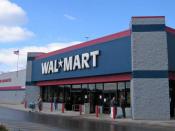In a world in which having a monopolistic competition market structure, Wal-Mart Stores, Inc. appears to have an oligopoly market structure. Nevertheless because are far too many retailers to deal with, they also have a monopolistic competition market structure. Regardless, Wal-Mart would rather have it this way because it has not hurt them at all by competition.
When Wal-Mart Stores, Inc. opened its doors to their first discount store in 1962, Sam Walton had no idea his business would take off as it has to this day. The reason for Wal-Mart's success has been their ability to create a basic structure for their very own business ecosystem. Wal-Mart came to the conclusion that if they offered a variety of brands and sold them about 15% cheaper than other retailers, this would make them a powerful force in the retail business.
In less than three decades of existence, Wal-Mart grew from a single small discount store in Rogers, Arkansas, to the largest retailer in the nation.
This title was previously held by Sears Roebuck and Co., but during the early 1990s was surpassed by Wal-Mart and Kmart. Sears after that regained the number two spot as the nation's leading retailers, but it appears Wal-Mart may never be caught.
At the end of 1996, Wal-Mart Supercenters had a 62% share of total supercenter sales. The sales for 1996 totaled $17.78 billion, up from the $11.51 billion for the precious year. These numbers and Wal-Mart's other numbers continue to grow year after year, and at this rate it may be hard to maintain a monopolistic competition market structure. They may have no choice but to consider themselves an oligopoly (Wal-Mart and Its Market Structure).
Impact of new companies entering the market"Wal-Mart is bracing for the entry of Tesco PLC, the largest...



Value and price
good paper on w-mart's marketing strategy. always good to attract consumers with value and price tactics
0 out of 0 people found this comment useful.